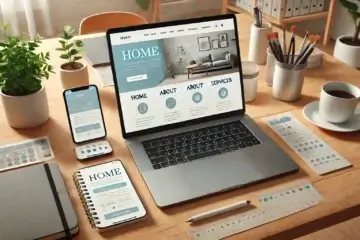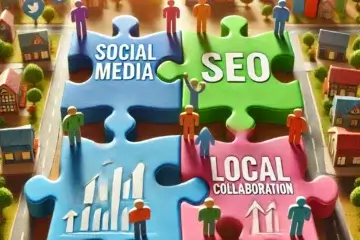In the vast expanse of the internet, where attention spans are fleeting and competition is fierce, how do you make your website stand out? The answer lies in the psychology of color. Understanding how colors influence emotions and behaviors can be the game-changer your website needs. This article is your guide to leveraging color theory in web design, helping you captivate your audience and leave a lasting impression. Whether you’re a seasoned web designer looking to enhance your skills or a business owner aiming to create a visually compelling online presence, this article is your roadmap to success in the digital realm.
Now that we’ve established the importance of color psychology in web design, let’s explore the fascinating world of colors in more detail. Each color carries its own unique psychological associations and can profoundly influence user behavior. Let’s break it down:
1. Red: The Power Player
Red is the color of passion, excitement, and urgency. It’s a bold choice that demands attention and drives action. Incorporating touches of red strategically can draw the eye to important elements on your website, such as call-to-action buttons or limited-time offers. Whether you’re aiming to increase conversions or create a sense of urgency, red can be your secret weapon.
However, it’s essential to use red sparingly and strategically. Too much red can overwhelm users and even evoke feelings of aggression. Instead, opt for subtle accents or pops of red to make a powerful statement without overwhelming your audience. By harnessing the power of red effectively, you can create a sense of excitement and urgency that motivates users to engage with your website and take action.
2. Blue: Trustworthiness Personified
Blue is the color of trust, reliability, and professionalism. It’s no wonder that many tech giants, such as Facebook and IBM, incorporate shades of blue into their branding. Blue has a calming effect on the mind and is universally appealing, making it an excellent choice for establishing trust with your audience. Whether you’re a small business or a multinational corporation, blue can help convey a sense of credibility and dependability.
Incorporating shades of blue into your website design can help create a cohesive and trustworthy brand identity. Whether it’s through your logo, navigation bar, or background elements, blue can instill confidence in your audience and encourage them to engage with your content. By leveraging the psychological power of blue, you can create a positive user experience that builds trust and fosters long-term relationships with your customers.
3. Yellow: Sunshine for the Soul
Yellow is the color of optimism, energy, and creativity. It’s like adding a ray of sunshine to your website design, instantly brightening the mood and capturing attention. Incorporating touches of yellow can create a sense of warmth and happiness, making your website more inviting and engaging for users. Whether you’re promoting a product or sharing valuable content, yellow can help you stand out from the crowd and leave a lasting impression.
However, it’s important to use yellow judiciously, as its brightness can be overwhelming in large doses. Instead, incorporate subtle accents or highlights of yellow to add visual interest to your design without overpowering your audience. By harnessing the psychological power of yellow, you can create a vibrant and energetic online presence that resonates with your target audience and inspires them to take action.
4. Green: The Color of Balance
Green is the color of balance, growth, and harmony. It’s often associated with nature and the environment, evoking feelings of freshness and vitality. Incorporating shades of green into your website design can create a sense of balance and tranquility, making it more appealing and inviting for users. Whether you’re promoting eco-friendly products or advocating for sustainability, green can help convey your brand’s values and resonate with your audience.
In addition to its calming effect, green is also associated with success and prosperity. Incorporating touches of green into your website can signify achievement and progress, reinforcing positive associations with your brand. Whether it’s through subtle accents or dominant design elements, green can help you create a visually appealing and harmonious online presence that connects with your audience on a deeper level.
5. Purple: Royalty and Sophistication
Purple is the color of luxury, creativity, and royalty. It’s a bold choice that conveys elegance and sophistication, making it perfect for brands that want to stand out from the crowd. Whether you’re targeting a high-end clientele or simply want to elevate your brand’s image, purple can help you create a memorable and refined online presence.
Incorporating hints of purple into your website design can add a touch of glamour and exclusivity, instantly capturing the attention of your audience. Whether it’s through subtle accents or dominant design elements, purple can help you create a sense of luxury and sophistication that sets your brand apart. By harnessing the psychological power of purple, you can create a visually stunning online presence that leaves a lasting impression on your audience.
Putting It All Together: Harmonizing Your Color Scheme
Now that you have a deeper understanding of the psychology behind different colors, it’s time to put your newfound knowledge into action. When selecting colors for your website, consider not only their individual meanings but also how they complement each other to create a harmonious and visually appealing palette.
Remember, there’s no one-size-fits-all approach to color theory in web design. Experiment with different combinations, solicit feedback from colleagues or friends, and trust your instincts. With the right colors, you can captivate your audience, convey your brand’s personality, and leave a lasting impression in the vast expanse of the digital world.
So go ahead, unleash your creativity, and paint the digital canvas with the colors of success!



0 Comments